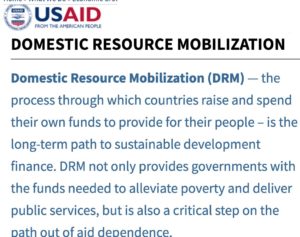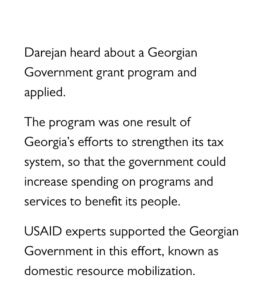How Much Foreign Aid to “Strengthen” Foreign Tax Collection?
Many articles supporting foreign aid tell of polls showing Americans think foreign aid is 25% of the federal budget when, these articles claim, foreign aid is only 1.2%. The Balance post, Current U.S. Discretionary Spending: FY 2019 Budget Request (updated July 7, 2018), explains the total federal budget and:
The discretionary budget does not include Social Security, Medicare, or Medicaid. These are part of the mandatory budget. These programs were authorized by previous Acts of Congress….
Next The Balance post complains about “the media” reporting on the federal deficit:
The media blames the discretionary budget for deficit spending, which has created a huge national debt. That’s a big concern, now that the debt to GDP ratio is more than 100 percent. What’s the best way to cut the budget deficit? Here are the five biggest myths.
However, the first of the “five biggest myths” listed is cutting foreign aid:
Myth #1: Just stop sending aid to foreign countries.
Fact: The United States only budgeted $1.9 billion on foreign aid for FY 2019. Cutting that wouldn’t do much to reduce the $984 billion budget deficit.
I’ve never heard anyone blame the federal budget deficit on foreign aid, but maybe someone has. The Balance lists the 2019 foreign aid budget at $1.9 billion (maybe this is a typo? It links to a bazillion page official federal budget document), but the Intelligent Economist, in an August 31, 2018 post, Types of Foreign Aid claims:
The U.S. spends roughly $50.1B in foreign aid each year which is only 1.2% of the Federal government’s budget.

So from these two websites we have U.S. foreign aid budgets that range from $1.9 billion to $50.1 billion.
The federal government’s Foreign Assistance.gov site splits the difference, listing “planned foreign assistance” at $27.7 billion for fiscal year 2019.
It is also worth noting that the Intelligent Economist post, in claiming foreign aid to be 1.2% of planned federal expenditures, uses the total 2019 federal budget instead of the more relevant 2019 federal discretionary budget. Using those numbers, the $50 billion foreign aid is 4 percent federal discretionary spending rather than 1.2 percent of total federal spending.
The Council on Foreign Relations offers a helpful Backgrounder on U.S. foreign aid debates, How Does the U.S. Spend Its Foreign Aid? (April 11, 2017), prompted by the Trump Administration’s proposals to significantly cut the 2018 foreign aid budget. Noting that defining foreign aid can be difficult, the Backgrounder says:
According to the nonpartisan Congressional Research Service (CRS), which uses the broadest definition of aid [PDF], including military and security assistance, total spending was nearly $49 billion in 2015. This accounts for roughly 1.3 percent of the federal budget.
Most valuable though are the foreign aid categories outlines in the Council on Foreign Relations article, drawing from Congressional Research Service report outlines “How is the Money Spent”:
U.S. aid policy seeks to achieve its aims through a diverse array of programs, which can be organized into several major categories. According to CRS calculations, foreign aid spending in 2015 broke down as follows:
• Long-term development aid (38 percent) …
• Military and security aid (35 percent)…
• Humanitarian aid (16 percent)…
• Political aid (11 percent)…
The key phrase here refers to intentions: “seeks to achieve its aims.” but it is not at all clear that past or current U.S. foreign aid expenditures have actually achieved or even made progress toward these aims.
Earlier posts have discussed the importance of international trade, investment, travel, and migration in promoting development and prosperity around the world. U.S. foreign aid tries to engage and assist private enterprises and NGOs, but also distracts and politicizes international relations.
Consider a “success story” profiled on the USAID website: FRUITFUL DREAMS
How Georgia’s strengthened tax system is helping entrepreneurs. With beautiful pictures and inspiring text, the story of an apparently successful enterprise unfolds:
It starts with a dream
Darejan Berdzenishvili had a dream.She would return from Tbilisi to her hometown in Guria with her husband Achinko and dog Rocky to start a dried fruit business.
However, Guria is one of the poorest regions in the Republic of Georgia, and Darejan lacked the funding to start her business.
I’m all for successful enterprises and wish the best for this one. But the success of this enterprise apparently turns on a USAID funding to help the Georgian government with “domestic resource mobilization”:
Darejan heard about a Georgian Government grant program and applied.
The program was one result of Georgia’s efforts to strengthen its tax system, so that the government could increase spending on programs and services to benefit its people.
USAID experts supported the Georgian Government in this effort, known as domestic resource mobilization.
So the U.S. taxpayer funded USAID funded program works to help collect more taxes so the Georgian government can choses with promising private enterprises to loan money too? What could go wrong…
You can read more about USAID’s Domestic Resource Allocation program.on their website, excerpt:
The Collecting Taxes Database (CTD) is part of an ambitious agenda of the international community to help countries strengthen their tax systems and mobilize domestic revenue. The dataset includes comparative information on a range of tax performance and tax administration variables for close to 200 countries and territories.
Advocates for tax reform often call for reducing taxes, arguing that when companies and consumers can keep more of their income, they can better make decisions that lead to expanding private enterprises and higher living standards. Another view, a government and foreign aid view, is that governments are better at “mobilize domestic revenue” and when they can better collect taxes from some, they can better help others start new companies.


